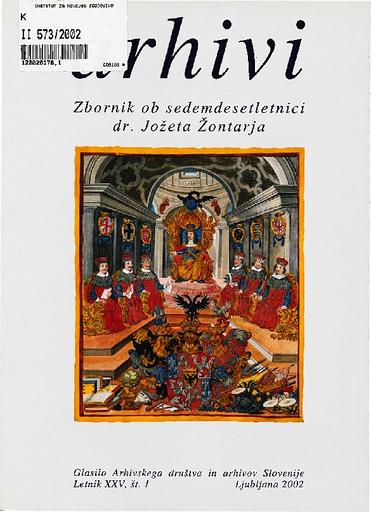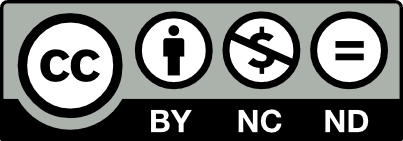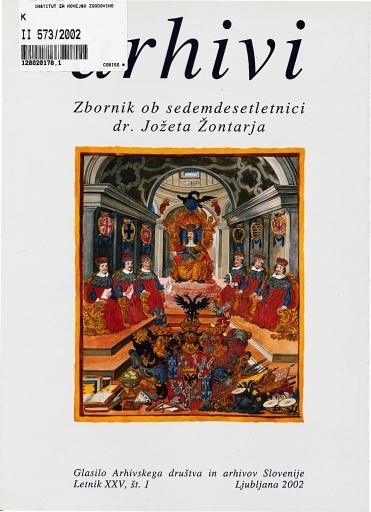/
Periodicals
/
Archives
Sourcesfor the history of the Slovene associative movements in the State Archives of Trieste

Author(s):Pierpaolo Dorsi
Co-author(s):Matevž Košir (ur.)
Year:2002
Publisher(s):Arhivsko društvo Slovenije, Ljubljana
Source(s):Arhivi, 2002, št. 1
Language(s):italijanščina
Type(s) of material:text
Keywords:slovenska manjšina, društva, Italija, Slovenci, arhivi, Trst, slovenske organizacije v zamejstvu, arhivsko gradivo, archival material, Slovene associative movements
Rights:

This work by Pierpaolo Dorsi is licensed under Creative Commons Attribution-NonCommercial-NoDerivs 4.0 International
Files (1)

Name:ARHIVI_2002-1.pdf
Size:27.42MB
Format:application/pdf
Permanent link:https://hdl.handle.net/11686/file307
Description
Between the second half of the 19th century and the
beginning of the 201 century, the independent association
became the typical form of bourgeois organisation.
This process was particularly important for the
nations, which like the Slovenes, did not have their own
state administration, especially in the areas where the
Slovene population lived among other ethnic groups.
This accounts for the historians' interest in the events
relating to the Slovene associations in Trieste and in
adjacent areas under the city's jurisdiction.
The first attempts to set up associations date back to
1848. Later, the movement spread to all strata of Slovene
society and it gradually specialised from the 1880s
onwards. A network of associations, catering for every
societal need within the national community was thus
established. Other nationalities created parallel and selfsufficient
societal circles. Both similarities and differences
can be observed between the association networks
organised by Slovenes, Italians, and Germans. After the
annexation to Italy, the associative movement of the Slovenes
underwent a process of adjustment. The latter was
interrupted by the fascist persecution that condemned
every independent association activity to illegality.
The authors dealing with the history of the Slovene
associative activity in and around Trieste found most of
the relevant documentary material in the State Archives
of Trieste. The archival fonds include the archival
material belonging to the Austrian, and later, Italian state
administrations, which governed the city from the mid-
18th to the late 20th century. The first systematic regulation
in the field of associations under the Austrian
system was the decree issued on 26 November 1852.
Very few Slovene associations were legally permitted to
pursue their activities in the Austrian coastal area while
this provision was in force. The constitutional principle
of the freedom of association was accepted under the law
of 15 November 1867. Under this law, the administrative
body controlling the creation of an association was the
regional political authority, represented by a Governor
whose seat was in Trieste. The "security authority," was
represented by either the Police administration in Trieste,
or by various district Capitanati, whose duties included
supervision of the associations' ordinary activities.
The existing official documents belonging to the
Trieste Governorship include the collections of statutes
constituting the "cadastral register" of regional associations,
the associations' index-files, and the official
documents regarding their creation and any subsequent
changes in the legal situation of those associations whose
seat was in the coastal area. The documentation regarding
the associations' activities is in the archives of
the Police administration in Trieste. The latter was
competent for the city and its surrounding areas and
numerous files mention the Slovene associations. A
simple glance through the list reveals the quality and
variety of the Slovene associations that were active in
Trieste and adjacent areas under the Austrian rule. The
co-operative associations or "industrial and economic
cooperatives," which led the growth and development of
the Slovene community, were subject to a special regime
under the Austrian legislation. The archival collection of
the Commercial and Maritime court, which is in the State
Archives of Trieste, includes the co-operatives' registration
documents and the entire "Register of cooperatives."
Immediately after the armistice of 1918, the
Italian administration maintained the same competences
as the preceding Austrian administration. Following the
legislative unification, the associations of the Julian
March were integrated into a new legal system. In Italy,
associations could be established without any compulsory
permits or official takeovers. However, the administrative
bodies had a broad discretionary right to dissolve
associations. The authoritarian regression led to a
1926 public security law, which subjugated all associations
to state control. Thus the archives of the Trieste
Prefecture, whose activity involved the surveillance of
associations, contain all the relevant archival material in
the collection "Cabinet documents." The documents
issued by the chief government commissioner (from
1952 onwards) can be a valuable resource for research of
Slovene socialising in contemporary Trieste.
Metadata (12)
- identifierhttps://hdl.handle.net/11686/9708
- title
- Le fonti per la storia dell'associazionismo sloveno nell'Archivio di Stato di Trieste
- Viri za zgodovino slovenskega združevanja v tržaškem Državnem arhivu
- Sourcesfor the history of the Slovene associative movements in the State Archives of Trieste
- creator
- Pierpaolo Dorsi
- contributor
- Matevž Košir (ur.)
- subject
- slovenska manjšina
- društva
- Italija
- Slovenci
- arhivi
- Trst
- slovenske organizacije v zamejstvu
- arhivsko gradivo
- archival material
- Slovene associative movements
- description
- Between the second half of the 19th century and the beginning of the 201 century, the independent association became the typical form of bourgeois organisation. This process was particularly important for the nations, which like the Slovenes, did not have their own state administration, especially in the areas where the Slovene population lived among other ethnic groups. This accounts for the historians' interest in the events relating to the Slovene associations in Trieste and in adjacent areas under the city's jurisdiction. The first attempts to set up associations date back to 1848. Later, the movement spread to all strata of Slovene society and it gradually specialised from the 1880s onwards. A network of associations, catering for every societal need within the national community was thus established. Other nationalities created parallel and selfsufficient societal circles. Both similarities and differences can be observed between the association networks organised by Slovenes, Italians, and Germans. After the annexation to Italy, the associative movement of the Slovenes underwent a process of adjustment. The latter was interrupted by the fascist persecution that condemned every independent association activity to illegality. The authors dealing with the history of the Slovene associative activity in and around Trieste found most of the relevant documentary material in the State Archives of Trieste. The archival fonds include the archival material belonging to the Austrian, and later, Italian state administrations, which governed the city from the mid- 18th to the late 20th century. The first systematic regulation in the field of associations under the Austrian system was the decree issued on 26 November 1852. Very few Slovene associations were legally permitted to pursue their activities in the Austrian coastal area while this provision was in force. The constitutional principle of the freedom of association was accepted under the law of 15 November 1867. Under this law, the administrative body controlling the creation of an association was the regional political authority, represented by a Governor whose seat was in Trieste. The "security authority," was represented by either the Police administration in Trieste, or by various district Capitanati, whose duties included supervision of the associations' ordinary activities. The existing official documents belonging to the Trieste Governorship include the collections of statutes constituting the "cadastral register" of regional associations, the associations' index-files, and the official documents regarding their creation and any subsequent changes in the legal situation of those associations whose seat was in the coastal area. The documentation regarding the associations' activities is in the archives of the Police administration in Trieste. The latter was competent for the city and its surrounding areas and numerous files mention the Slovene associations. A simple glance through the list reveals the quality and variety of the Slovene associations that were active in Trieste and adjacent areas under the Austrian rule. The co-operative associations or "industrial and economic cooperatives," which led the growth and development of the Slovene community, were subject to a special regime under the Austrian legislation. The archival collection of the Commercial and Maritime court, which is in the State Archives of Trieste, includes the co-operatives' registration documents and the entire "Register of cooperatives." Immediately after the armistice of 1918, the Italian administration maintained the same competences as the preceding Austrian administration. Following the legislative unification, the associations of the Julian March were integrated into a new legal system. In Italy, associations could be established without any compulsory permits or official takeovers. However, the administrative bodies had a broad discretionary right to dissolve associations. The authoritarian regression led to a 1926 public security law, which subjugated all associations to state control. Thus the archives of the Trieste Prefecture, whose activity involved the surveillance of associations, contain all the relevant archival material in the collection "Cabinet documents." The documents issued by the chief government commissioner (from 1952 onwards) can be a valuable resource for research of Slovene socialising in contemporary Trieste.
- Med drugo polovico 19. stoletja in v začetku 20. stoletja so se samostojna društva uveljavila kot tipična oblika organizacije meščanske družbe. Ta proces je bil posebej pomemben za tiste narode - kot so Slovenci -, ki še niso imeli državne ureditve, in še posebej na tistih ozemljih, na katerih je slovenski narod živel v stiku z različnimi etničnimi skupinami. Od tod izhaja zanimanje zgodovinarjev za dogodke, povezane s slovenskim združevanjem v Trstu in na ozemlju, ki ga je to mesto upravljalo. Prvi pojavi takšnega združevanja v Trstu, segajo v leto 1848 in gibanje kasneje zajema vedno več slojev slovenske družbe. Od osemdesetih let naprej je značilna postopna specializacija z ustanovitvijo omrežja društev, ki želijo zadovoljiti vsako potrebo po družabnosti znotraj narodne skupnosti. Različne narodnosti so sestavljale vzporedne in samozadostne društvene kroge; opazimo lahko podobnosti in razlike v omrežjih družb, ki so jih ustanavljali Slovenci, Italijani in Nemci. Po priključitvi k Italiji je društveno gibanje Slovencev preživelo obdobje prilagajanja, ki ga je ustavilo preganjanje fašistične vlade: vsaka neuvrščena društvena dejavnost seje morala zateči k ilegali. Avtorji, ki so se ukvarjali z zgodovino slovenskega združevanja v Trstu in pokrajini, so tovrstno dokumentarno gradivo našli predvsem v državnem Arhivu, v katerem so zbrani fondi avstrijskih in kasneje italijanskih državnih uprav, ki so delovale v mestu od polovice 18. stoletja do poznega 20. stoletja. V avstrijskem sistemu je bil prvi sistematični predpis na področju društev patent, izdan 26. novembra 1852; zelo malo je bilo slovenskih društev, ki jih je le-ta uradno dovolil v avstrijskem Primorju v obdobju njegove veljave. Ustavno načelo o svobodi druženja seje uresničilo z zakonom z dne 15. novembra 1867. Po tem zakonu je bil upravni organ, kije imel pomembno vlogo ob oblikovanju društva, pokrajinska politična oblast, katere zastopnik je bilo Namestništvo s sedežem v Trstu. "Varnostna oblast", katere zastopnik je bila Uprava policije v Trstu ali razni okrajni Kapitanati, pa je imela nalogo nadzorovati redno dejavnost društev. Med akti Namestništva v Trstu so shranjene zbirke statutov, ki sestavljajo "kataster" pokrajinskih društev, kartoteko društev in akte, ki se nanašajo na ustanovitev in na poznejše spremembe pravnega položaja društev, ki so imela sedež v Primorju. Dokumentacijo o življenju društev je treba iskati predvsem v fondu Uprave policije v Trstu, ki je bila pristojna za mesto in okolico; v številnih mapah se omenjajo slovenska društva: iz preprostega branja seznama sta razvidni kakovost in raznolikost slovenskih društev iz Trsta in okolice v avstrijskem obdobju. Avstrijska zakonodaja je podvrgla pod poseben režim zadružna društva ali "industrijske in ekonomske zadruge", ki so bile gonilna sila za rast slovenske skupnosti. V tržaškem državnem arhivu Fond trgovskega in morskega sodišča vključuje akte za registracijo zadrug in celoten "Register zadrug". Po premirju iz leta 1918 je italijanska uprava v prvem obdobju imela enake pristojnosti, kot jih je imela pred njo avstrijska. Po zakonodajni združitvi so se društva Julijske krajine vključila v nov pravni sistem: v Italiji za ustanovitev društva ni bilo predpisanih dovoljenj ali uradnih prevzemov, ampak so upravni organi imeli široko diskrecijsko pravico pri razpustitvi društev. Avtoritarno nazadovanje je privedlo do oblikovanja zakona za javno varnost iz leta 1926, ki je vsa društva podjarmil državnemu nadzoru. V tem okviru je delovala Prefektura v Trstu; v njenem arhivskem fondu je v seriji "Akti kabineta" zbrano celotno gradivo, ki zadeva društva. Akti kabineta glavnega komisariata vlade (od 1952) so lahko koristni za raziskavo slovenskega druženja v sodobnem Trstu.
- publisher
- Arhivsko društvo Slovenije
- date
- 2002
- type
- besedilo
- language
- Italijanščina
- isPartOf
- rights
- license: ccByNcNd
Citirano v (1)
| Tipologija | Avtor(ji) | Naslov | Kraj | Založba | Leto |
|---|---|---|---|---|---|
| 1.01 Izvirni znanstveni članek | Ličen, Daša | Zbližati, izobraziti in razvedriti slovanski živelj : članstvo Slavjanskega društva v Trstu ob pomladi narodov | Ljubljana | Zveza zgodovinskih društev Slovenije | 2022 |
